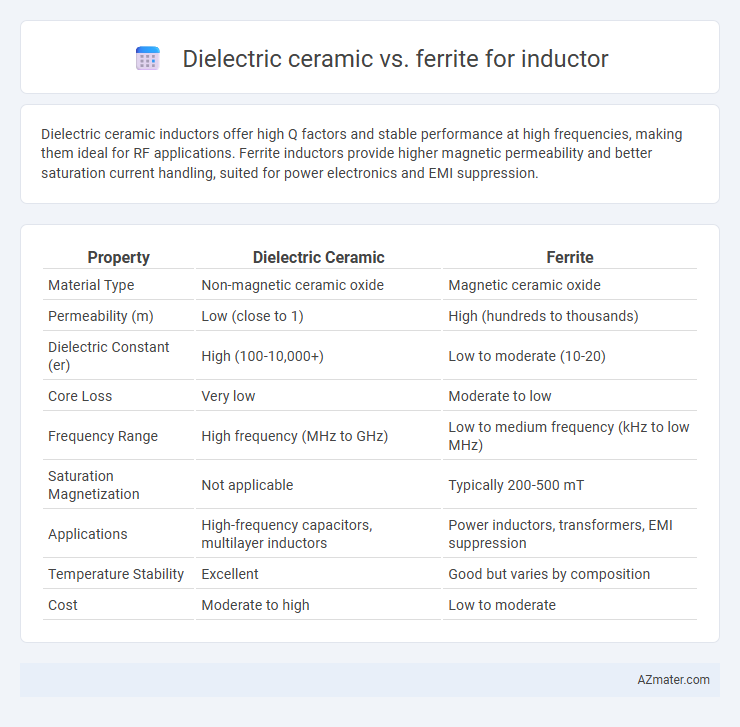Dielectric ceramic inductors offer high Q factors and stable performance at high frequencies, making them ideal for RF applications. Ferrite inductors provide higher magnetic permeability and better saturation current handling, suited for power electronics and EMI suppression.
Table of Comparison
| Property | Dielectric Ceramic | Ferrite |
|---|---|---|
| Material Type | Non-magnetic ceramic oxide | Magnetic ceramic oxide |
| Permeability (m) | Low (close to 1) | High (hundreds to thousands) |
| Dielectric Constant (er) | High (100-10,000+) | Low to moderate (10-20) |
| Core Loss | Very low | Moderate to low |
| Frequency Range | High frequency (MHz to GHz) | Low to medium frequency (kHz to low MHz) |
| Saturation Magnetization | Not applicable | Typically 200-500 mT |
| Applications | High-frequency capacitors, multilayer inductors | Power inductors, transformers, EMI suppression |
| Temperature Stability | Excellent | Good but varies by composition |
| Cost | Moderate to high | Low to moderate |
Overview of Inductor Core Materials
Dielectric ceramic cores offer high-frequency performance with low loss and excellent stability, making them ideal for RF and microwave inductors. Ferrite cores provide high magnetic permeability and low core losses at lower frequencies, enhancing inductance and efficiency in power inductors and transformers. Selection depends on frequency range, magnetic properties, and application-specific requirements.
What Are Dielectric Ceramic Inductors?
Dielectric ceramic inductors utilize high-permittivity ceramic materials to store energy and provide inductance in compact, high-frequency applications, offering stable performance with low losses. These inductors excel in RF circuits due to their excellent Q-factor and minimal magnetic interference, unlike ferrite inductors that rely on magnetic properties and perform better at lower frequencies. Dielectric ceramics enable miniature inductor designs with enhanced frequency response, making them ideal for wireless communication and advanced electronic devices.
Understanding Ferrite Inductors
Ferrite inductors utilize ferrite materials known for their high magnetic permeability and low electrical conductivity, which minimizes eddy current losses and enhances efficiency in high-frequency applications. These inductors are preferred in power electronics and RF circuits due to their superior magnetic saturation properties and better thermal stability compared to dielectric ceramic inductors. Ferrite inductors also offer improved inductance stability under varying temperature conditions, making them ideal for demanding environments requiring reliable performance.
Material Composition and Structure Comparison
Dielectric ceramic inductors utilize advanced ceramic materials primarily composed of barium titanate or similar compounds with high permittivity, enabling low-loss and high-Q performance suitable for high-frequency applications. Ferrite inductors, composed mainly of iron oxide combined with metallic elements like manganese, zinc, or nickel, feature a crystalline spinel or garnet structure that provides high magnetic permeability and efficient energy storage at lower frequencies. The contrasting material compositions result in dielectric ceramics offering superior electrical insulation and stability, while ferrites deliver robust magnetic properties, influencing their respective inductance ranges and frequency response behaviors.
Magnetic and Electrical Properties
Dielectric ceramic inductors exhibit low magnetic permeability and high electrical resistivity, resulting in minimal core losses and suitability for high-frequency applications. Ferrite inductors offer high magnetic permeability and low eddy current losses, enabling efficient energy storage and strong magnetic coupling at lower frequencies. The choice between dielectric ceramic and ferrite materials directly impacts inductor performance, with ferrites favored for high inductance and magnetic efficiency, while dielectric ceramics excel in high-frequency stability and low noise.
Frequency Performance and Efficiency
Dielectric ceramic inductors exhibit superior high-frequency performance due to their low magnetic losses and high Q factors, making them ideal for applications above 100 MHz. Ferrite inductors, while offering higher inductance values and excellent efficiency at lower frequencies (typically below 30 MHz), suffer increased core losses and reduced Q at high frequencies. Choosing dielectric ceramic inductors enhances efficiency and minimizes signal loss in RF circuits, whereas ferrite inductors are preferred for power applications requiring sizable inductance and robust magnetic properties.
Thermal Stability and Reliability
Dielectric ceramic inductors offer superior thermal stability with minimal inductance variation across temperature ranges, making them reliable for applications requiring consistent performance under thermal stress. Ferrite inductors, while cost-effective and providing high permeability, typically exhibit greater inductance drift and reduced thermal stability at elevated temperatures. Selection between dielectric ceramic and ferrite inductors depends on the criticality of maintaining stable inductance and long-term reliability in high-temperature environments.
Cost Analysis: Dielectric Ceramic vs Ferrite
Dielectric ceramic inductors typically have lower material costs due to the abundant availability of ceramic components compared to ferrite, which requires more complex manufacturing processes involving specialized magnetic materials. Ferrite inductors often incur higher production expenses because of their magnetic properties and frequency performance, making them preferable for high-frequency applications despite increased costs. Cost efficiency in selecting between dielectric ceramic and ferrite inductors depends on application frequency, power requirements, and volume production scale.
Application Suitability in Modern Circuits
Dielectric ceramic inductors offer high Q-factors and low losses, making them ideal for high-frequency applications such as RF circuits and wireless communication devices. Ferrite inductors provide superior magnetic permeability and high inductance values, which suit power management and EMI suppression in switching regulators and audio equipment. Modern circuit designs often select dielectric ceramics for compact, high-frequency filtering while relying on ferrite materials for energy storage and noise reduction in power electronics.
Choosing the Right Inductor Core Material
Dielectric ceramic and ferrite materials significantly influence the performance of inductors, with ferrite cores offering high magnetic permeability and low core loss for efficient energy storage in low-frequency applications. Dielectric ceramic cores provide high electrical insulation and stable performance at high frequencies but lower permeability than ferrites, making them suitable for RF and high-frequency circuits. Selecting the right inductor core material depends on operating frequency, core losses, magnetic permeability, and thermal stability requirements to optimize inductance and efficiency.

Infographic: Dielectric ceramic vs Ferrite for Inductor
 azmater.com
azmater.com